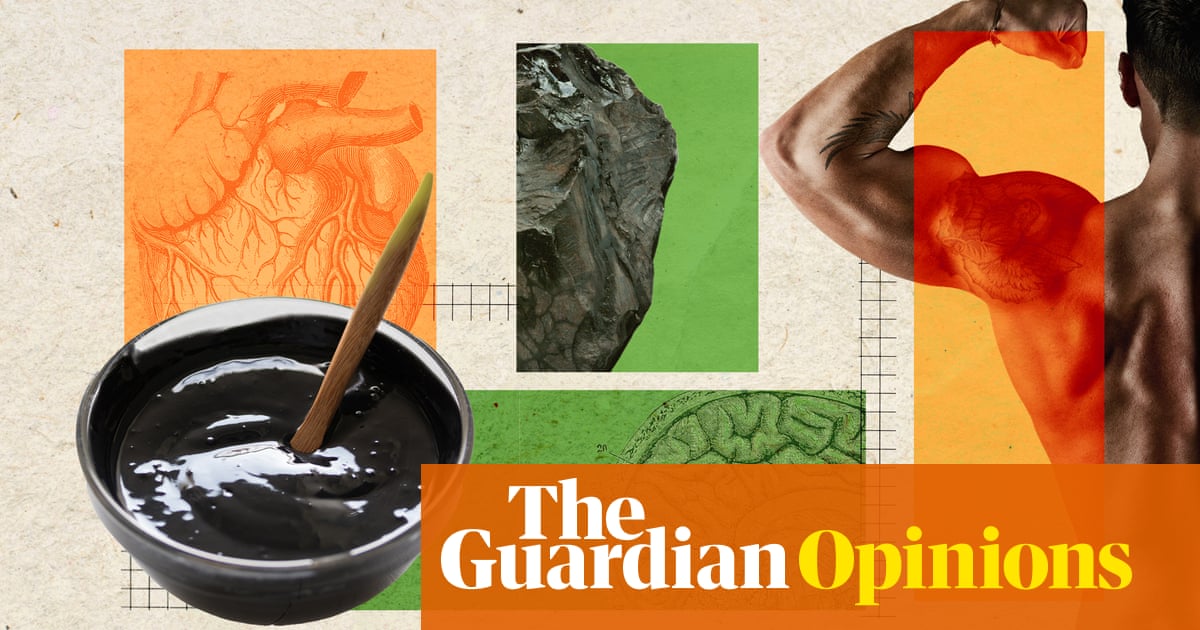Gender biases embedded in the way social media algorithms serve us content are well documented: algorithms have been found to amplify misogynistic content and unduly objectify women’s bodies, and are often cited as a driver of political polarisation between young men and women.
If you are online and of the male persuasion, you are more likely than me to have encountered videos extolling the supposed masculine benefits of substances such as shilajit and ashwagandha. Interest in shilajit has taken off in recent years, in no small part thanks to square-jawed men who pose with jars of the stuff in TikToks and Instagram posts, looking like perfect caricatures of virility with their fastidiously groomed facial hair and inexplicable shirtlessness.
What is shilajit?
A black, tarry substance commonly stirred into water or milk as a drink, shilajit is variously purported by male influencers to boost testosterone levels, muscle growth, libido, brain function, energy and vitality, among other claims.
Also known as mumijo, mumie and rock sap, shilajit is a mineral substance that comes from rocks in mountainous regions.
Dr Ian Musgrave, a molecular pharmacologist at the University of Adelaide, describes shilajit as “a variety of plant and soil material that has been compressed down as part of mountain-building formation. A lot of it comes from around the Himalayas.”
The composition of shilajit varies widely depending on the source location, but it is primarily made up of humic substances – “a range of organic acids typically found in soil as a result of breakdown of organic material,” Musgrave says. Other components of shilajit include various minerals such as calcium, potassium, and magnesium; resin and waxy materials; and amino acids, the building blocks of proteins.
The substance has been used for millennia in the Ayurveda and Siddha systems of traditional medicine originating in India.
Prof Dennis Chang, the director of the National Institute of Complementary Medicine at Western Sydney University, points out that “traditional use is not equal to scientific evidence”.
“All medicines should be subject to the same level of rigour in terms of scientific evaluation, including their efficacy, their safety as well as their quality,” he says.
What does the evidence say?
Shilajit is naturally occurring, but that is no guarantee of safety. Groundwaters in the Himalayas where shilajit is commonly found “tend to have a lot of arsenic in them,” Musgrave says, warning of the risk of potential contamination.
In Australia, there are no products containing shilajit listed on the Australian Register of Therapeutic Goods, meaning the substance is not regulated as a complementary medicine.
“There’s quite a bit of shilajit on sale in Australia,” Musgrave says. “In some of these preparations there are more heavy metals – things like lead and arsenic – than is allowed in current regulations.”
Musgrave, who has previously found issues with the content of herbal medicines sold in Australia, says while many shilajit products available would have relatively low levels of heavy metals, there was no guarantee of safety. “You have a good chance of being poisoned by these things,” he says.
As for the purported health effects, one review found that despite its long history of use, shilajit “lacks scientific evaluation” and there was no “substantial evidence” that it has a biological effect in the body.
On claims that it boosts testosterone, “the evidence is very thin on the ground,” Musgrave says. A systematic review on testosterone boosters found that shilajit was “possibly effective”, noting that a study on its benefit in middle-aged men had a “high risk of bias” because it was funded by a firm that manufactured the product.
Research on shilajit’s cognitive effects has been conducted in rodents, Musgrave notes. “A lot of these things that are quite promising in preclinical studies, especially in relationship to memory, really don’t translate out to what happens in humans because of differences in biochemistry.
“This material – provided you get can get it from a source where you know what the heavy metal concentrations are – is generally rather inoffensive, but it’s also generally unlikely to do anything.”
What about ashwagandha?
Ashwagandha, of the plant Withania somnifera, is also commonly used in Ayurvedic medicine, with claims of boosting fertility, reducing stress and improving sleep.
The results of several clinical trials do suggest that ashwagandha may help reduce stress and anxiety. Research into its impacts on sleep is more limited, but a 2021 review found that ashwagandha extract had a “small but significant effect on overall sleep” compared to placebo.
The evidence that it has any benefit for male infertility, however, is “too limited” and not sufficiently robust, a meta-analysis found.
Last year, the Therapeutic Goods Administration issued a safety advisory for ashwagandha, linking it to gastrointestinal side effects and very rare cases of liver injury.
Chang notes that the liver damage is likely the result of idiosyncratic drug reactions in some people, meaning “it’s very hard to predict, and it could happen to anyone, but the incidence is not as high”.
“Liver damage from ashwagandha is fairly uncommon,” Musgrave agrees. “It’s possibly due to metabolism of the materials that are within the plant itself.”
But to his mind, it raises an important question: “Is there any point in buying expensive supplements with the possibility of getting liver damage when there’s no really significant benefit to be had?”
-
Donna Lu is Guardian Australia’s science writer
-
Antiviral is a fortnightly column that interrogates the evidence behind the health headlines and factchecks popular wellness claims

 3 months ago
154
3 months ago
154

















































